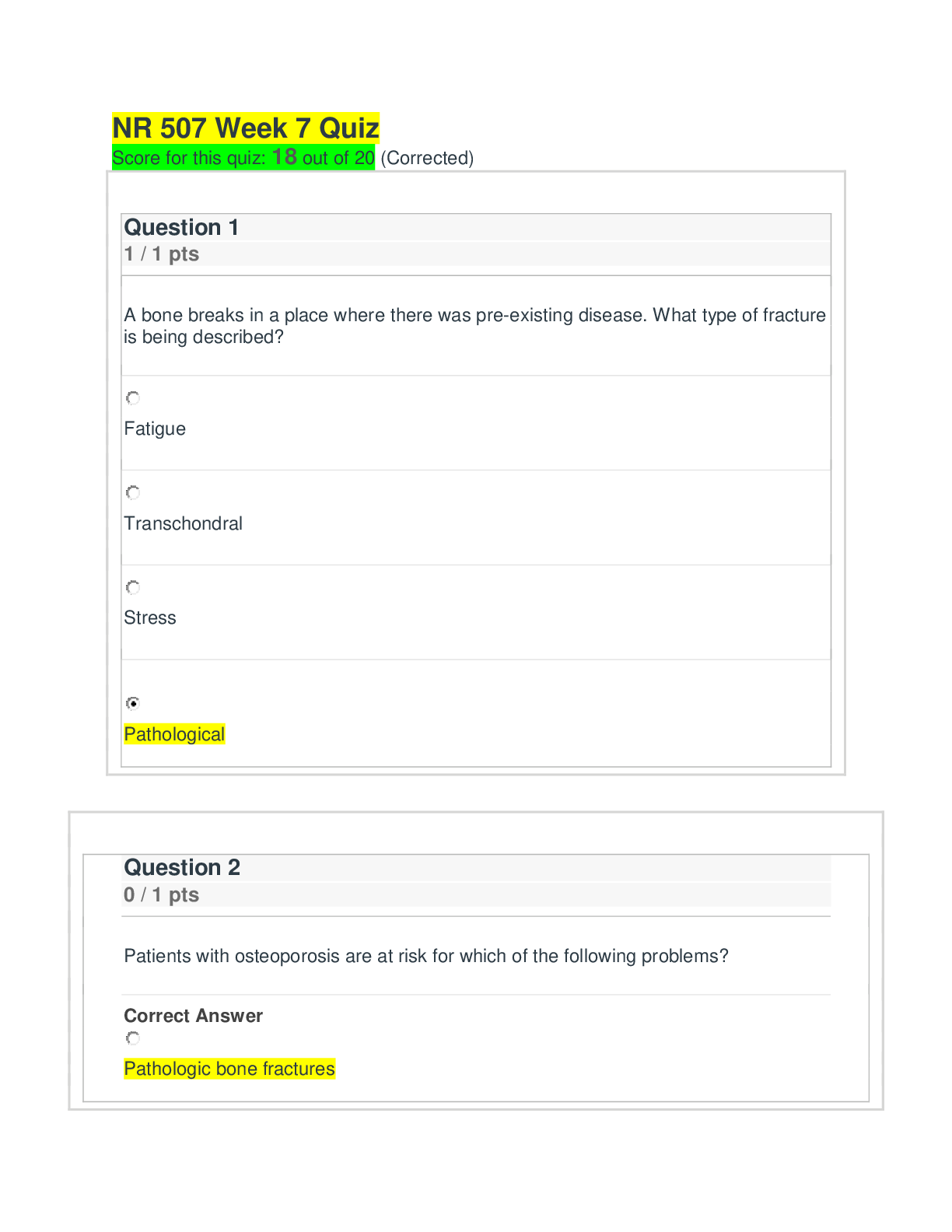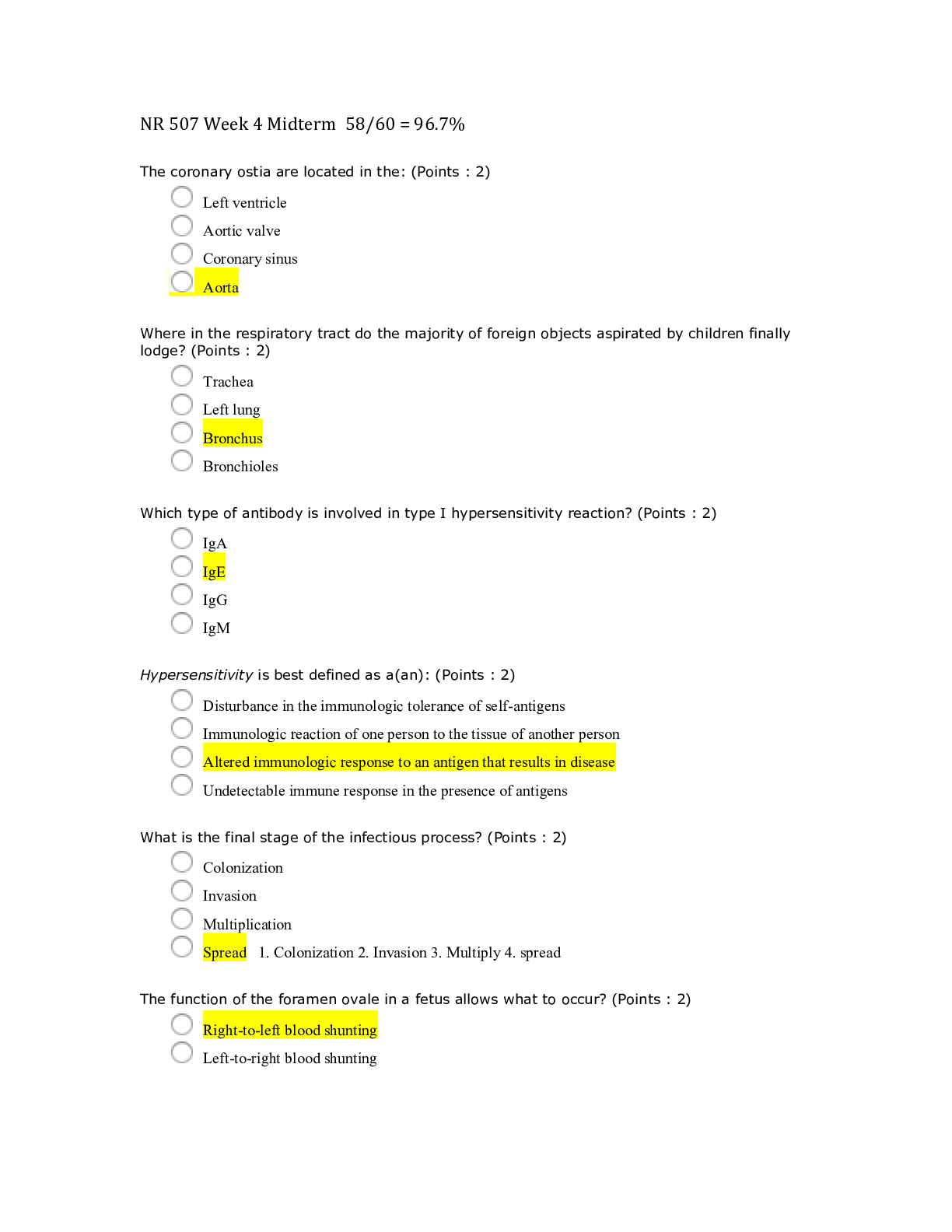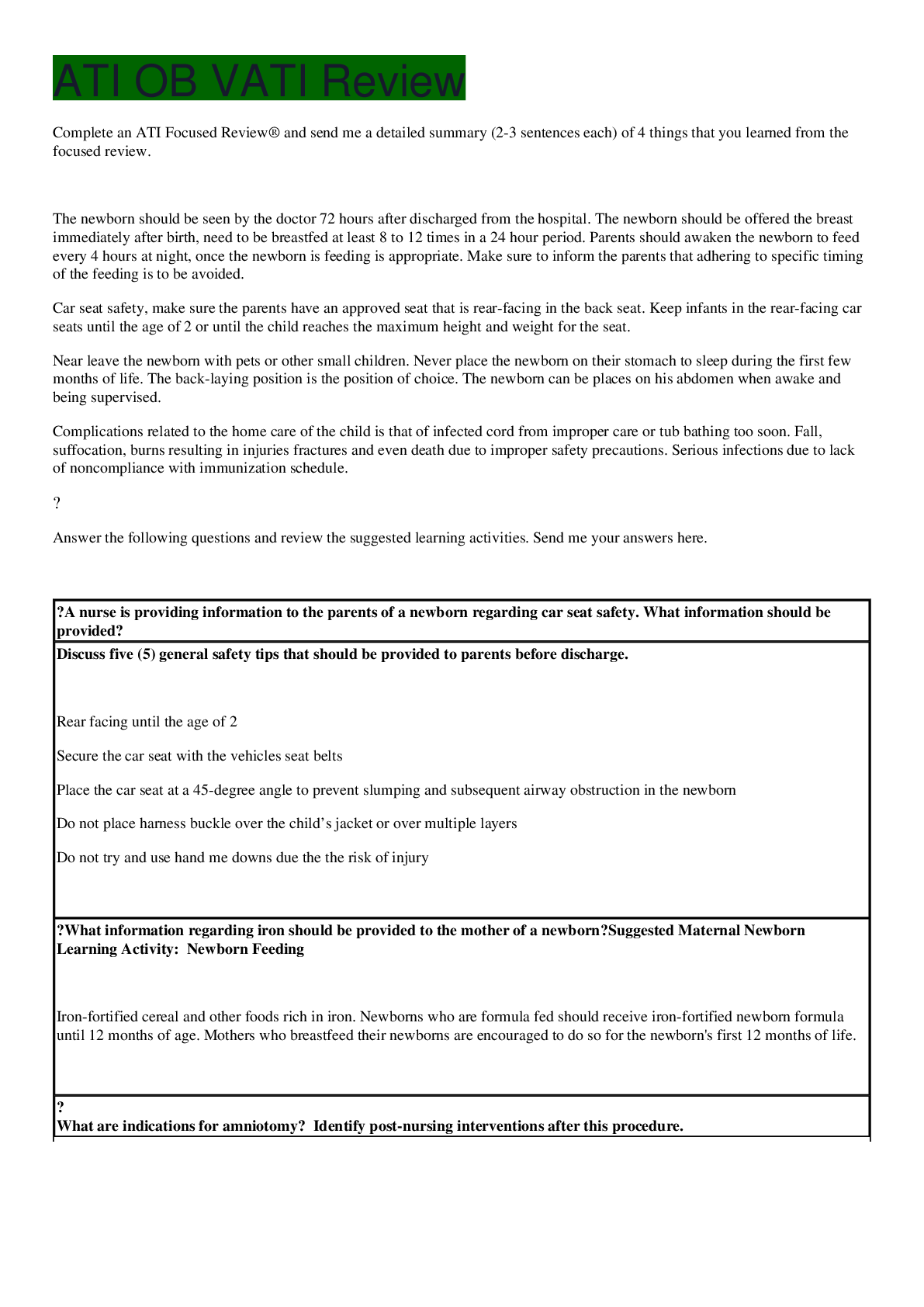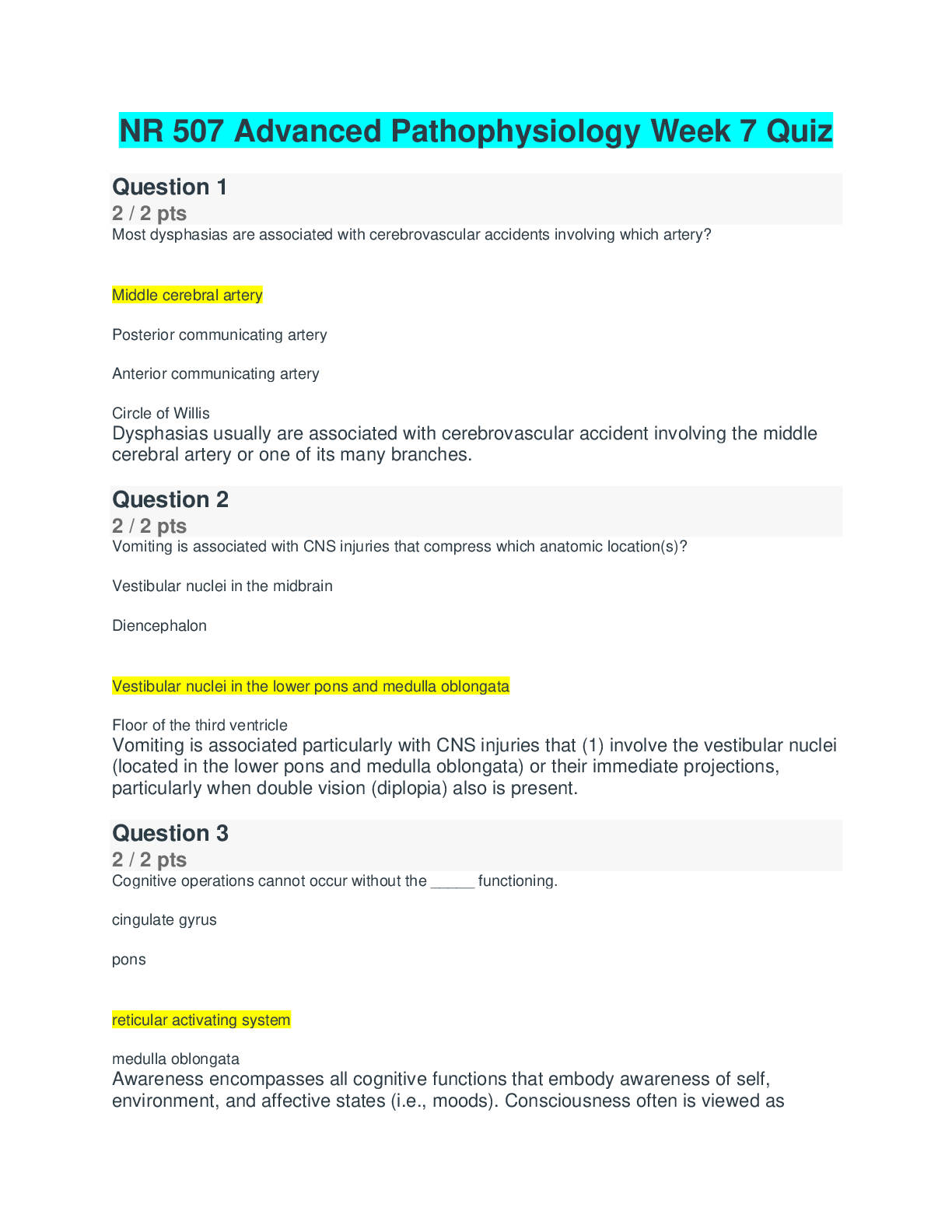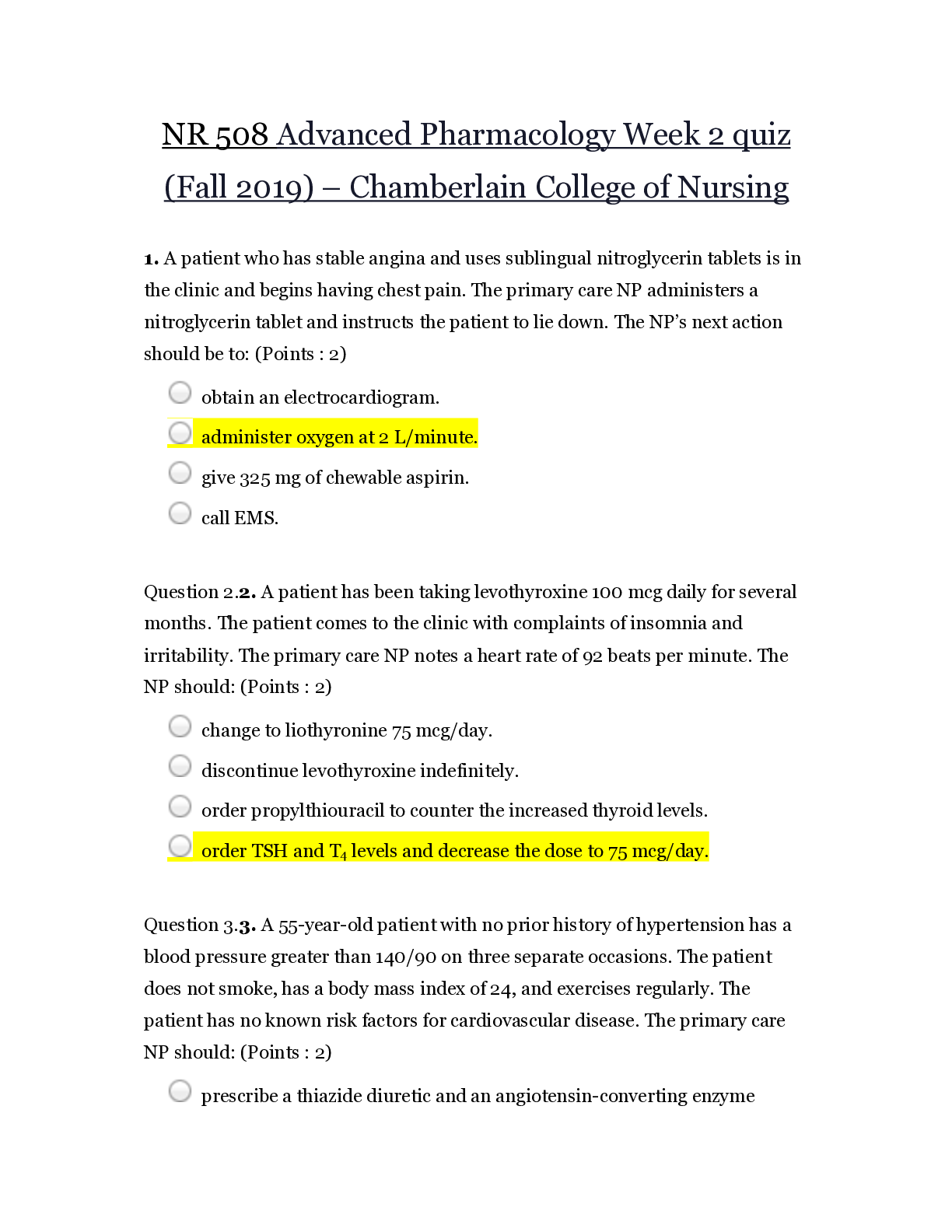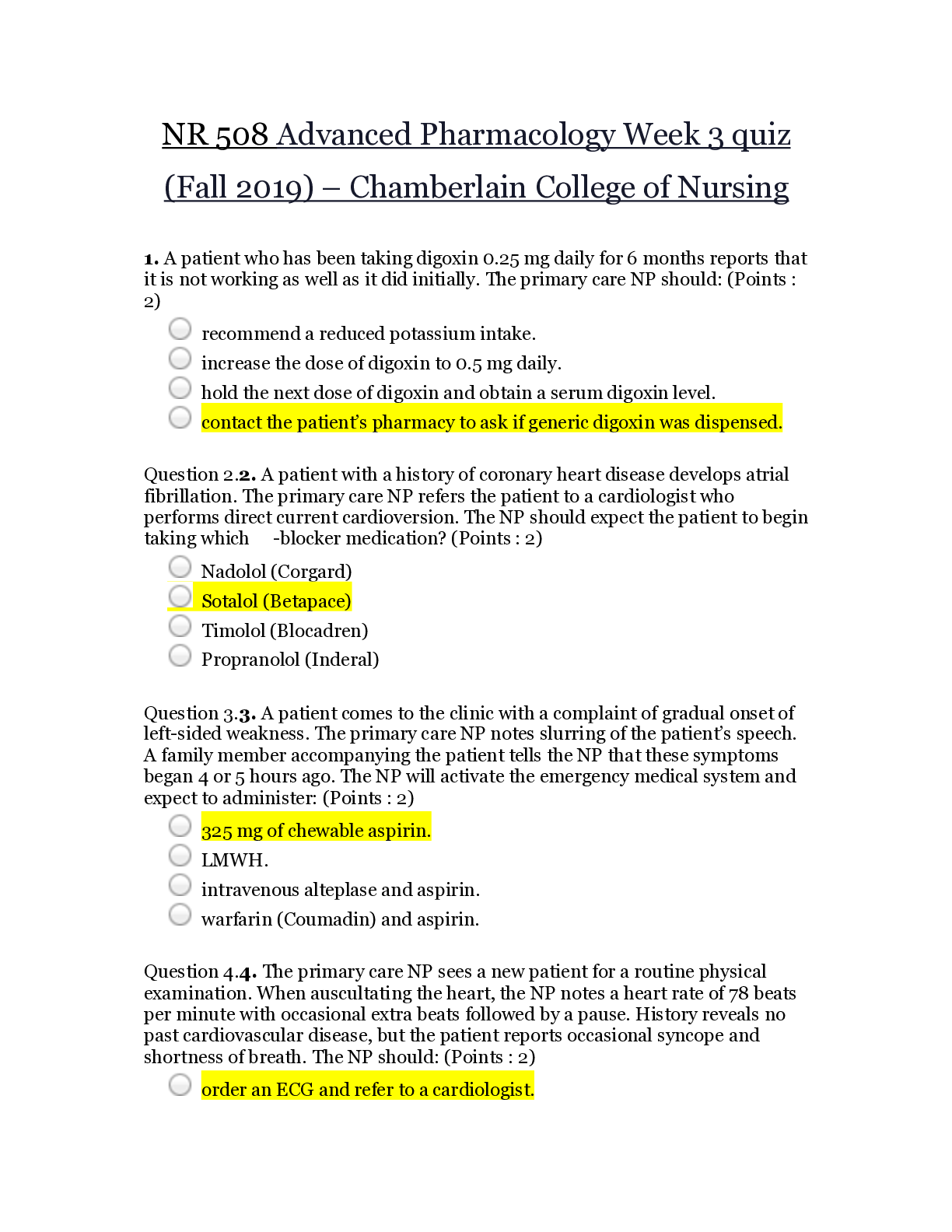*NURSING > EXAM > NR507 Advanced Pathophysiology Week 3 Quiz Version 2 – Chamberlain College of Nursing | NR 507 Adv (All)
NR507 Advanced Pathophysiology Week 3 Quiz Version 2 – Chamberlain College of Nursing | NR 507 Advanced Pathophysiology Week 3 Quiz Version 2
Document Content and Description Below
NR507 Advanced Pathophysiology Week 3 Quiz Version 2 – Chamberlain College of Nursing Advanced Pathophysiology Week 3 Quiz- Version 2 Question 1 2 / 2 pts In some anemias, the erythrocytes are ... present in various sizes, which is referred to as Correct! anisocytosis. poikilocytosis. microcytosis. isocytosis. Additional descriptors of erythrocytes associated with some anemias include anisocytosis (assuming various sizes) or poikilocytosis (assuming various shapes) (Figure 26-1). Question 2 2 / 2 pts What is the pathophysiologic process of aplastic anemia? Correct! Autoimmune disease against hematopoiesis by activated cytotoxic T cells Inherited genetic disorder with recessive X-linked transmissionMalignancy of the bone marrow in which unregulated proliferation of erythrocytes crowd out other blood cells Autoimmune disease against hematopoiesis by activated immunoglobulins Most cases of AA result from an autoimmune disease directed against hematopoietic stem cells. Cytotoxic T cells (Tc cells) appear to be the main culprits. Question 3 2 / 2 pts The body compensates for anemia by Correct! increasing rate and depth of breathing. capillary vasoconstriction. hemoglobin holds on to oxygen more firmly. kidneys release more erythropoietin. Tissue hypoxia creates additional demands and compensatory actions on the pulmonary and hematologic systems. The rate and depth of breathing increase in an attempt to increase the availability of oxygen. Question 4 2 / 2 pts A woman complains of chronic gastritis, fatigue, weight loss, and tingling in her fingers. Laboratory findings show low hemoglobin and hematocrit levels, and a high mean corpuscular volume. These findings are consistent with _____ anemia. aplastic iron deficiencyfolate deficiency Correct! pernicious Gastric atrophy commonly occurs in the presence of type A chronic gastritis and may be autoimmune. Autoantibodies against gastric parietal cells are frequently observed. When the hemoglobin level in the blood has decreased significantly (7 to 8 g/dl), the individual experiences the classic symptoms of anemia—weakness, fatigue, paresthesias of the feet and fingers, difficulty in walking, loss of appetite, abdominal pains, and weight loss. Question 5 2 / 2 pts Symptoms of polycythemia vera are mainly the result of Correct! increased blood viscosity. destruction of erythrocytes. a decreased erythrocyte count. neurologic involvement. As the disease progresses many of the symptoms are related to the increased blood cellularity and viscosity. Question 6 0 / 2 pts Untreated pernicious anemia is fatal, usually because of You Answeredbrain hypoxia. liver hypoxia. renal failure. Correct Answer heart failure. Untreated PA is fatal, usually because of heart failure. Question 7 2 / 2 pts What is the most common cause of vitamin K deficiency? Administration of warfarin (Coumadin) An IgG-mediated autoimmune disorder Liver failure Correct! Total parenteral nutrition (TPN) with antibiotic therapy The most common cause of vitamin K deficiency is parenteral nutrition in combination with broad-spectrum antibiotics that destroy normal gut flora. Question 8 2 / 2 pts Which of the following is a description consistent with chronic lymphocytic leukemia (CLL)? Correct! There is failure of B cells to mature into plasma cells that synthesize immunoglobulins.The bone marrow and peripheral blood are characterized by leukocytosis and a predominance of blast cells. As the immature blasts increase, they replace normal myelocytic cells, megakaryocytes, and erythrocytes. The translocation of genetic material from genes 9 and 22 creates an abnormal, fused protein identified as BCR-ABL. There are defects in the ras oncogene, TP53 tumor-suppressor gene, and INK4A, the gene encoding a cell-cycle regulatory protein. Thus CLL is derived from transformation of a partially mature B cell that has not yet encountered antigen. Question 9 0 / 2 pts Local signs and symptoms of Hodgkin disease–related lymphadenopathy are a result of Correct Answer pressure and obstruction. ischemia and pressure. You Answered inflammation and ischemia. obstruction and pressure. Local symptoms caused by pressure and obstruction of the lymph nodes are the result of lymphadenopathy. Question 10 2 / 2 pts Heparin-induced thrombocytopenia (HIT) is described as a(n)IgE-mediated allergic drug reaction that reduces circulating platelets. Correct! IgG immune-mediated adverse drug reaction that reduces circulating platelets. cell-mediated drug reaction in which macrophages process the heparin and platelet complexes that are then destroyed by activated cytotoxic T cells. hematologic reaction to heparin in which the bone marrow is unable to produce sufficient platelets to meet the body’s needs. Heparin is a common cause of drug-induced thrombocytopenia. HIT is an immunemediated, adverse drug reaction caused by IgG antibodies that leads to increased platelet consumption and a decrease in platelet counts. Question 11 2 / 2 pts In a full-term infant, the normal erythrocyte life span is _____ days, whereas the adult is _____ days. 120 to 130; 150 90 to 110; 140 30 to 50; 80 Correct! 60 to 80; 120 In full-term infants, normal erythrocyte life span is 60 to 80 days; in premature infants it may be as short as 20 to 30 days; and in children and adolescents, it is the same as that in adults—120 days.Question 12 2 / 2 pts What is the name of the disorder in which levels of bilirubin remain excessively high in the newborn and are deposited in the brain? Jaundice Icterus neonatorum Icterus gravis neonatorum Correct! Kernicterus Without replacement transfusions, in which the child receives Rh-negative erythrocytes, the bilirubin is deposited in the brain, which is a condition called kernicterus. Question 13 2 / 2 pts Hemophilia B is caused by clotting factor _____ deficiency. V X VIII Correct! IX Hemophilia B (Christmas disease) is caused by factor IX deficiency. Question 14 2 / 2 ptsErythroblastosis fetalis is defined as an autosomal dominant hereditary disease. allergic disease in which maternal blood and fetal blood are antigenically incompatible. Correct! alloimmune disease in which maternal blood and fetal blood are antigenically incompatible. autoimmune disease in immature nucleated cells that are released into the bloodstream. HDN is an alloimmune disease in which maternal blood and fetal blood are antigenically incompatible, causing the mother’s immune system to produce antibodies against fetal erythrocytes. Question 15 2 / 2 pts The type of anemia that occurs as a result of thalassemia is macrocytic, normochromic. microcytic, normochromic. macrocytic, hyperchromic. Correct! microcytic, hypochromic. The anemic manifestation of thalassemia is microcytic-hypochromic hemolytic anemia. Question 16 2 / 2 pts The sickle cell trait differs from sickle cell disease in that the child with sickle cell traithas a milder form of the disease that is characterized by vaso-occlusive crises and is believed to result from higher hemoglobin values and viscosity. has the mildest form of the disease with normal hemoglobin and hemoglobin F, which prevents sickling. Correct! inherited normal hemoglobin A from one parent and Hb S from the other parent, whereas the child with sickle cell disease has Hb S from both parents. has a mild form of sickle cell disease that causes sickling during fever and infection, but not during acidosis or hypoxia, whereas the child with sickle cells disease develops sickling during each of these conditions. Sickle cell–thalassemia disease and sickle cell–Hb C disease are heterozygous forms in which the child simultaneously inherits another type of abnormal hemoglobin from one parent. Sickle cell trait, in which the child inherits Hb S from one parent and normal Hb A from the other, is a heterozygous carrier state that rarely has clinical manifestations (Table 28-3). Question 17 0 / 2 pts Which of the following can trigger an immune response within the bloodstream that can result in an embolus? You Answered Fat Bacteria Air Correct AnswerAmniotic fluid Amniotic fluid not only displaces blood, reducing oxygen, nutrient, and waste exchange, but also introduces antigens, cells, and protein aggregates that trigger inflammation, coagulation, and the immune response within the bloodstream. Question 18 2 / 2 pts Which disorder causes a transitory truncal rash that is nonpruritic and pink with erythematous macules that may fade in the center, making them appear as a ringworm? Fat emboli Bacterial endocarditis Correct! Rheumatic fever Myocarditis of acquired immunodeficiency syndrome Erythema marginatum is a distinctive truncal rash that often accompanies acute rheumatic fever. It consists of nonpruritic, pink erythematous macules that never occur on the face or hands. Question 19 0 / 2 pts Which form of cardiomyopathy is characterized by ventricular dilation and grossly impaired systolic function, leading to dilated heart failure? Dystrophic Septal You AnsweredHypertrophic Correct Answer Dilated Dilated cardiomyopathy (congestive cardiomyopathy) is characterized by ventricular dilation and grossly impaired systolic function, leading to dilated heart failure. Question 20 0 / 2 pts Which of the following is manufactured by the liver and primarily contains cholesterol and protein? Triglycerides (TGs) You Answered High-density lipoproteins (HDLs) Correct Answer Low-density lipoproteins (LDLs) Very-low-density lipoproteins (VLDLs) A series of chemical reactions in the liver results in the production of several lipoproteins that vary in density and function. These include VLDLs, primarily TG and protein; LDLs, mostly cholesterol and protein; and HDLs, mainly phospholipids and protein. Question 21 2 / 2 pts When does most cardiovascular development occur? Between the eighth and 10th weeks of gestationBy the 28th day of gestation Correct! Between the fourth and seventh weeks of gestation Between the 12th and 14th weeks of gestation Cardiogenesis begins at approximately 3 weeks of gestation; however, most cardiovascular development occurs between the fourth and seventh weeks. Question 22 2 / 2 pts When does systemic vascular resistance in infants begin to rise? Correct! Once the placenta is removed from circulation One hour after birth During the beginning stage of labor One month before birth Removal of the low-resistance placenta from circulation causes an immediate increase in systemic vascular resistance to about twice that before birth. Question 23 0 / 2 pts Which heart defect produces a systolic ejection murmur at the right upper sternal border that transmits to the neck and left lower sternal border with an occasional ejection click? Hypoplastic left heart syndromePulmonic stenosis Correct Answer Aortic stenosis You Answered Coarctation of the aorta A systolic ejection murmur at the right upper sternal border that transmits to the neck and left lower sternal border is produced by blood flow through the stenotic area. An ejection click may be heard with valvular arterial stenosis. Question 24 2 / 2 pts Which congenital heart defects occur in trisomy 13, trisomy 18, and Down syndrome? Atrial septal defect and dextrocardia Coarctation of the aorta and pulmonary stenosis Tetralogy of Fallot and persistent truncus arteriosus Correct! Ventricular septal defect and patent ductus arteriosus Congenital heart defects that are related to dysfunction of trisomy 13, trisomy 18, and Down syndrome include ventricular septal defect and patient ductus arteriosus (see Table 31-2). Question 25 2 / 2 pts What is the most important clinical manifestation of aortic coarctation in the neonate? Correct!Congestive heart failure (CHF) Pulmonary hypertension Cerebral hypertension Cor pulmonale The newborn usually presents with CHF symptoms. Once the ductus closes, these infants deteriorate rapidly from the development of hypotension, acidosis, and shock. [Show More]
Last updated: 1 year ago
Preview 1 out of 14 pages

Buy this document to get the full access instantly
Instant Download Access after purchase
Add to cartInstant download
We Accept:

Reviews( 0 )
$12.50
Document information
Connected school, study & course
About the document
Uploaded On
Aug 16, 2020
Number of pages
14
Written in
Additional information
This document has been written for:
Uploaded
Aug 16, 2020
Downloads
0
Views
45














